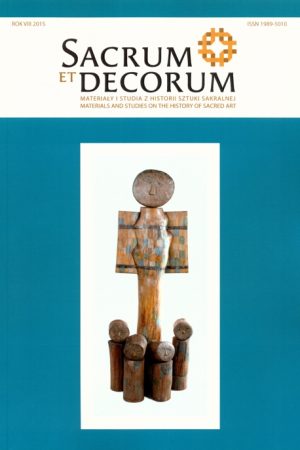Postać św. Franciszka w sztuce i myśli Jerzego Nowosielskiego. Wystrój kościoła oo. Franciszkanów-Reformatów pw. Niepokalanego Poczęcia Najświętszej Marii Panny na Azorach w Krakowie (1977–1978)
Słowa kluczowe:
Jerzy Nowosielski, franciszkanie, ikona współczesna, św. Franciszek, Kraków, malarstwo monumentalne, droga krzyżowaAbstrakt
Św. Franciszek – jeden z najbardziej popularnych świętych, kanonizowany w 1228 roku, pozostaje świętym „ekumenicznym” – szanowanym również przez prawosławie. „Biedaczyna z Asyżu” okazał się także niezwykle ważny zarówno dla duchowości, jak i sztuki krakowskiego awangardowego malarza i prawosławnego myśliciela – Jerzego Nowosielskiego, który ubolewał, że zachodnia świadomość chrześcijańska całkowicie spłyciła główne idee świętego, sprowadzając je do naiwnego sentymentalizmu. W powrocie do idei św. Franciszka artysta upatrywał nadzieję na odrodzenie się chrześcijaństwa i ożywienie współczesnej myśli teologicznej. Jednym z ważnych śladów tradycji franciszkańskiej w sztuce Nowosielskiego są tzw. krzyże franciszkańskie – polichromowane wyobrażenia Ukrzyżowanego, typu croce dipinta, croce storiata, wzorowane na słynnym krzyżu z San Damiano. Nowosielski namalował takich krzyży kilkadziesiąt, przeznaczając je zarówno do celów liturgicznych (jako zwieńczenie ikonostasu lub tetrapodu), jak i do dewocji prywatnej. Postać św. Franciszka pojawiła się także kilkakrotnie w jego sztuce monumentalnej: polichromii kościoła w Olszynach (1957) i w Zbylitowskiej Górze (1956–1957), a także w mozaice Stygmatyzacja św. Franciszka dla kościoła w Izabelinie pod Warszawą (1980) – jednak realizacje te uległy niestety zniszczeniu. Najciekawszą i najbardziej rozbudowaną „franciszkańską” realizacją Nowosielskiego pozostaje wystrój wnętrza kościoła oo. Franciszkanów-Reformatów pw. Niepokalanego Poczęcia Najświętszej Marii Panny na Azorach w Krakowie, nawiązujący do kanonu kościołów reformackich: stacje drogi krzyżowej oraz wielkie panneau ołtarzowe. Do dzieł tych – łączących duchowość ikony z estetyką awangardy – artysta wprowadził wątki ikonograficzne charakterystyczne dla tradycji wschodniej: dwukrotnie użyty motyw mandylionu, temat Anastazis, motyw Orantki, formę Płaszczanicy jako ostatnią stację drogi krzyżowej (Złożenia do grobu) oraz wizerunki trzech skazańców w scenach pasyjnych, odwołujące się do żywego w prawosławiu kultu św. Łotra. Również przedstawienie wielookiego Serafina zdradza wpływ wcześniejszej, bizantyńskiej ikonografii angelologicznej, z kolei interpretacja stygmatyzacji św. Franciszka nawiązuje do trzynastowiecznej ikonografii włoskiej, ale także do wizerunku św. Franciszka z witrażu Stanisława Wyspiańskiego z przełomu wieków XIX i XX w krakowskim kościele Franciszkanów. Rozbudowana symbolika retabulum z Azorów, łącząca wątki franciszkańskie, eucharystyczne i pasyjne, oraz czerpiąca wiele wątków z tradycji prawosławnej zyskała w interpretacji krakowskiego malarza – dzięki lapidarności ascetycznej formy i odważnej kolorystyce – charakter monumentalny.Downloads
Pobrania
Opublikowane
Jak cytować
Numer
Dział
Licencja
Prawa autorskie (c) 2015 Sacrum et Decorum

Utwór dostępny jest na licencji Creative Commons Uznanie autorstwa – Użycie niekomercyjne – Bez utworów zależnych 4.0 Międzynarodowe.
Zgodnie z polityką Open Access autorzy zachowują pełnię praw autorskich do swoich artykułów – bez ograniczeń.
Autorzy mogą deponować swoje artykuły w wybranym przez siebie repozytorium.


